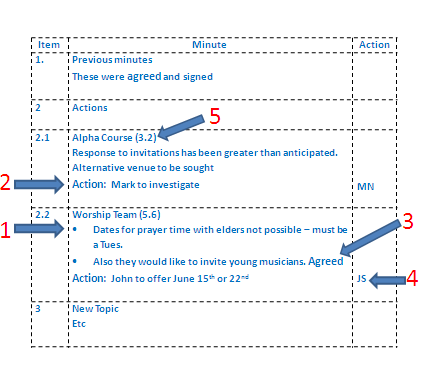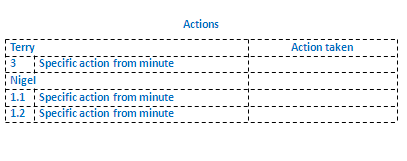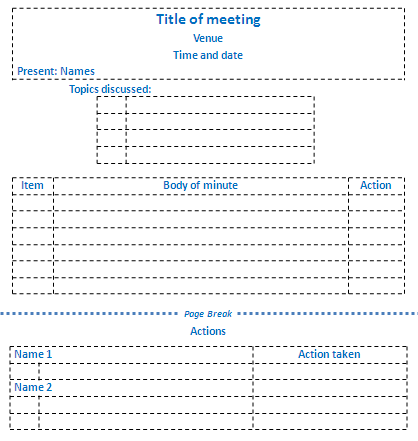A literary masterpiece?
 Minutes are recorded to serve those present and to ensure that the decisions taken are followed through. Failing to take minutes, or making them ‘inaccessible’ through poor presentation, may represent a loss of benefit from the original meeting. Minutes should not seek to have the accolade of a literary masterpiece! They are functional. Familiar and well-understood abbreviations or shortened sentences are perfectly acceptable if that makes them easier to use.
Minutes are recorded to serve those present and to ensure that the decisions taken are followed through. Failing to take minutes, or making them ‘inaccessible’ through poor presentation, may represent a loss of benefit from the original meeting. Minutes should not seek to have the accolade of a literary masterpiece! They are functional. Familiar and well-understood abbreviations or shortened sentences are perfectly acceptable if that makes them easier to use.
Formatting
Some simple formatting can also help (see below – numbers correspond to those in the illustration).
1. Bullet points often promote clarity as they highlight the key points being made.
2. Text should not look ‘heavy’. Blocks of text are daunting to read so it is better to have short sentences and paragraphs separated appropriately with lines to give white space on the page.
3. Decisions should be clearly identified within the text. Words like ‘Agreed’ can be highlighted by making them ‘bold’.
4. Similarly ‘Actions’ need to be clearly identified e.g.
Action: John Smith to prepare report.
John Smith’s initials are then placed in the third column at the same horizontal level as the text of the stated action
5. Where actions from the previous meeting are being followed up include the number of that previous minute in brackets after the heading

How to handle Actions
The body of a minute may refer to a particular action to be taken. As illustrated, I put the initials of the person taking that action in the 3rd column. Once the minutes have been completed all the actions associated with each individual are then grouped at the end with the item number and sufficient detail to ensure the action can be understood without referring to the minutes. Thus that individual can quickly work through the list from this short summary.
NB This action list does not form a part of the minutes (i.e. it does not need ‘signing off’ as a part of a legal document) and should be on a separate page. It is just a tool for efficiency and to save time.
Follow up of the actions is carried out in advance of the subsequent meeting. By receiving reports of the actions before the meeting it is not necessary to take valuable time during the meeting to review actions unless further discussion is required. So a list such as the following is circulated in advance – perhaps 2 weeks in advance – so that everyone can respond by a stated date.

The responses are combined and pre-circulated. In preparing the Agenda (also to be pre-circulated) only those items that require further discussion are included. The other items are assumed to have been understood and agreed by all parties.
Template
The template for Minutes, including all the aspects discussed in this short series, thus looks like this:

I suggest you now create a similar table and save it as a Template (in word as .dot) for future use. Remember, the grid I have shown should be concealed in the final minutes. It has been shown in these illustrations purely to help you create the format.
This concludes the series on Effective Meetings. To summarise I have sought to address:
1. Overview of meetings
2, 3 Types of meeting
4, 5 Agendas
6 Chairing meetings
7, 8 Minutes and Actions
